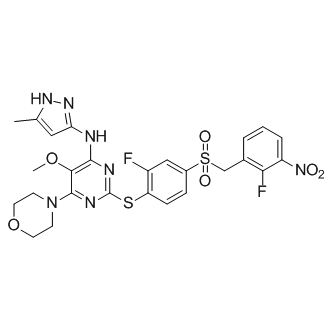| Cas No.: | 1798871-30-3 |
| SMILES: | CC1=CC(=NN1)NC2=NC(=NC(=C2OC)N3CCOCC3)SC4=C(C=C(C=C4)S(=O)(=O)CC5=C(C(=CC=C5)[N+](=O)[O-])F)F |
| Formula: | C26H25F2N7O6S2 |
| M.Wt: | 633.65 |
| Purity: | >98% |
| Sotrage: | 2 years -20°C Powder, 2 weeks 4°C in DMSO, 6 months -80°C in DMSO |
| Description: | Centrinone is a selective and reversible inhibitor of polo-like kinase 4 (PlK4) with a Ki of 0.16 nM. |
| Target: | PLK4:0.16 nM (Ki) PLK4 (G95L):68.57 nM (Ki) Aurora A:171 nM (Ki) Aurora B:436.76 nM (Ki) |
| In Vitro: | Centrinone exhibits more than 1000-fold selectivity for Plk4 over Aurora A/B and does not affect cellular Aurora A or B substrate phosphorylation at concentrations that deplete centrosomes. Centrinone treatment of HeLa human cervical carcinoma cells leads to a progressive reduction in foci containing centriolar and pericentriolar material markers at each round of cell division, until most cells lack centrioles and centrosomes. Treatment with centrinone reduces centriole number in multiciliated Xenopus epithelial cells, which indicates that Plk4 also controls centriole amplification in differentiated cells. Centrinone treatment causes centrosome depletion in human and other vertebrate cells. Centrosome loss irreversibly arrests normal cells in a senescence-like G1 state by a p53-dependent mechanism that is independent of DNA damage, stress, Hippo signaling, extends mitotic duration, or segregation errors[1]. |
| Kinase Assay: | Purified 6xHis-tagged human Plk4 kinase domain is in 20 mM Tris pH 7.5, 100 mM NaCl, 10% glycerol, 1 mM DTT. 2X reaction buffer consists of 50 mM HEPES pH 8.5, 20 mM MgCl2, 1 mM DTT, 0.2 mg/mL BSA, 16 μM ATP, and 200 μM A-A11 substrate. The Plk4 concentration in the final reaction is 2.5-10 nM with a final pH of 8.0. Inhibitors (Centrinone) array in dose response are added from DMSO stocks. Reactions are allowed to proceed for 4-16 hours at 25°C. Detection is performed using ADP-Glo reagent. Luminescence is measured on an plate reader[1]. |
| Cell Assay: | For each condition, cells are seeded in triplicate into 6-well plates at 50,000 cells/well. 125 nM centrinone is added to HeLa cells or 300 nM is added to NIH/3T3 cells. At 24-hour intervals, 3 wells are harvested per condition. Cell counting is performed using a TC10 automated cell counter[1]. |
| References: | [1]. Wong YL. et al. Cell biology. Reversible centriole depletion with an inhibitor of Polo-like kinase 4. Science. 2015 Jun 5;348(6239):1155-60. |

 DC Chemicals' products qualify for U.S. tariff exemptions. We guarantee no price increases due to customs duties and maintain stable supply, continuing to deliver reliable research solutions to our American clients.
DC Chemicals' products qualify for U.S. tariff exemptions. We guarantee no price increases due to customs duties and maintain stable supply, continuing to deliver reliable research solutions to our American clients.





















